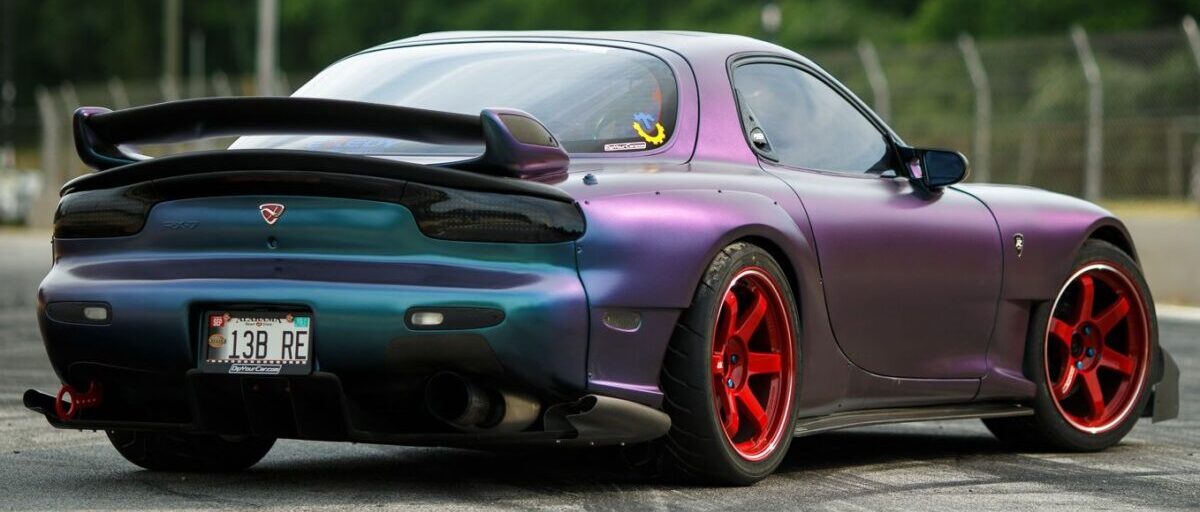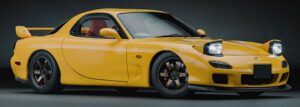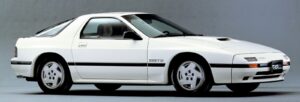Generation Gap: Ranking each and every Mazda RX-7
1. 1992-2002 FD
3. 1985-1992 FC
1992-2002 FD
Generation Gap: Ranking each and every Mazda RX-7. The Mazda RX-7 FD, produced from 1992 to 2002, is a classic and iconic sports car that gained popularity for its sleek design and rotary engine technology. Here are some key features and specifications:
- Rotary Engine (13B-REW): The RX-7 FD is renowned for its unique rotary engine, a 1.3-liter twin-rotor 13B-REW. This engine configuration distinguishes the RX-7 from traditional piston engines, providing a high-revving and smooth power delivery.
- Turbocharging: The FD model of the RX-7 is equipped with a sequential twin-turbo system. The setup includes a smaller turbo for low rpm responsiveness and a larger turbo for higher-end power, contributing to an impressive power band.
- Performance: The RX-7 FD is recognized for its excellent handling and performance. It features a well-balanced chassis, lightweight design, and a low center of gravity, making it agile and responsive on the road or track.
- Body Design: The FD RX-7 is known for its sleek, aerodynamic design. It has a distinctive front end with pop-up headlights and a smooth, flowing body that enhances its overall aesthetic appeal.
- Interior: The interior of the RX-7 FD is driver-focused, with a cockpit-style design. It typically includes supportive bucket seats, a sporty instrument cluster, and a layout emphasizing the driver’s connection to the car.
- Pop-Up Headlights: One of the distinctive features of the RX-7 FD is its pop-up headlights, a characteristic design element that adds to its nostalgic appeal.
- Limited Production: The RX-7 FD had limited production numbers, adding to its desirability among automotive enthusiasts and collectors. The scarcity of these models contributes to their value in the used car market.
- Cultural Impact: The RX-7 FD has left a lasting impact on automotive culture and is often celebrated in various media, including movies, video games, and car enthusiast communities.
Overall, the Mazda RX-7 FD is celebrated for its unique rotary engine, exceptional handling, and timeless design, making it a sought-after classic sports car among automotive enthusiasts.
1979-1985 SA/FB
The Mazda RX-7 SA/FB, produced from 1979 to 1985, is a notable sports car that contributed to the popularity of rotary engine technology. Here’s a detailed description of the key features and characteristics:
- Rotary Engine (12A and later 13B): The RX-7 SA/FB is powered by a rotary engine, with early models featuring the 12A engine and later ones transitioning to the more potent 13B engine. The rotary engine, known for its compact size and high-revving nature, distinguishes the RX-7 from conventional piston-powered sports cars.
- Body Design: The SA/FB RX-7 is recognized for its sleek and aerodynamic design. It features a distinctive long hood, a low-slung profile, and a rearward cabin placement, giving it a classic sports car silhouette. The pop-up headlights contribute to its clean and uncluttered front end.
- Lightweight Construction: The RX-7 SA/FB incorporates lightweight materials in its construction, contributing to its nimble handling and performance. The emphasis on weight reduction enhances the overall driving experience.
- Handling and Balance: With a front-engine, rear-wheel-drive layout and a well-balanced chassis, the RX-7 SA/FB offers excellent handling characteristics. The combination of a lightweight design and balanced weight distribution contributes to its agility on the road.
- Interior: The interior of the RX-7 SA/FB is driver-centric, featuring a simple and functional design. It typically includes sporty bucket seats, a straightforward instrument cluster, and controls oriented towards the driver for a focused driving experience.
- Pop-Up Headlights: Similar to the RX-7 FD, the SA/FB model is equipped with pop-up headlights, a design feature that was popular during that era and adds to the car’s distinctive appearance.
- Cultural Significance: The RX-7 SA/FB holds cultural significance as one of the early Japanese sports cars that gained recognition in the global market. Its combination of rotary power and a stylish design contributed to Mazda’s reputation for producing innovative and sporty vehicles.
- Motorsport Legacy: The RX-7 SA/FB also left its mark in motorsports, particularly in various racing series. Its success on the track further solidified its reputation as a capable and competitive sports car.
In summary, the Mazda RX-7 SA/FB is celebrated for its rotary engine, lightweight design, and engaging driving dynamics. Its classic styling and cultural impact have made it a sought-after collectible among automotive enthusiasts.
1985-1992 FC
The Mazda RX-7 FC, produced from 1985 to 1992, represents the second generation of the RX-7 series. Here’s a detailed description of the key features and characteristics of this model:
- Rotary Engine (13B-REW): Like its predecessor, the RX-7 FC is powered by a rotary engine. The 13B-REW engine, specifically in the Turbo II variant, is a 1.3-liter twin-rotor engine with a turbocharger. This engine configuration is known for delivering smooth power delivery and a high-revving performance.
- Turbocharging: The Turbo II variant of the RX-7 FC features a turbocharger, enhancing the engine’s power output. This addition contributes to improved performance and acceleration, making it a more dynamic sports car.
- Body Design: The RX-7 FC showcases a more angular and aggressive design compared to its predecessor. It features pop-up headlights and a distinctive, aerodynamic shape that contributes to both aesthetics and performance.
- Weight Distribution: The RX-7 FC is known for its near 50:50 weight distribution, which enhances its handling and cornering capabilities. This balanced weight distribution, coupled with a rear-wheel-drive layout, provides a responsive and engaging driving experience.
- Suspension System: The FC model incorporates a MacPherson strut front suspension and an independent rear suspension, contributing to its stable and well-controlled ride. This setup helps the RX-7 FC maintain composure during spirited driving.
- Interior: The interior of the RX-7 FC is driver-focused, featuring a sporty and ergonomic design. It typically includes supportive bucket seats, a driver-oriented instrument cluster, and controls placed for easy access.
- Convertible Option: In addition to the coupe version, the RX-7 FC was also available as a convertible. The convertible variant retained the sleek design of the coupe but offered open-air driving for those who preferred a more immersive experience.
- Performance and Handling: The RX-7 FC is recognized for its overall performance and handling characteristics. With a combination of a lightweight chassis, a powerful rotary engine, and well-tuned suspension, it delivers a thrilling driving experience.
- Cultural Impact: The RX-7 FC, like its predecessors, has made a significant impact on automotive culture. It gained popularity in various racing series and has a dedicated fan base among car enthusiasts.
In summary, the Mazda RX-7 FC is celebrated for its rotary engine, turbocharged performance, balanced weight distribution, and distinctive design, making it a classic sports car with a strong legacy in the automotive world.
Are you already a proud owner of a Mazda RX-7? If so, check out our selection of parts for this car at the following link:
https://octoclassic.com/product-category/mazda/rx-7
Photos sources: pinterest.com, autoevolution.com, favcars.com, Pinterest











